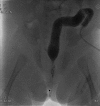Anorectal Malformations
- PMID: 29487488
- PMCID: PMC5825858
- DOI: 10.1055/s-0037-1609020
Anorectal Malformations
Abstract
Anorectal malformation are common congenital problems occurring in 1 in 5,000 births and have a spectrum of anatomical presentations, requiring individualized treatments for the newborn, sophisticated approaches to the definitive reconstruction, and management of long-term treatments and outcomes. Associated anomalies related to the cardiac, renal, gynecologic, orthopedic, spinal, and sacral systems impact care and prognosis. Long-term results are good provided there is an accurate anatomical reconstruction and a focus on maximizing of functional results.
Keywords: anorectal malformation; cloaca; imperforate anus; pediatric fecal incontinence.
Figures






References
-
- Stephens F D, Smith E eds. Chicago, IL: Year Book Medical; 1971. Incidence, frequency of types, etiology. In: Anorectal Malformations in Children; pp. 160–171.
-
- Santulli T V. The treatment of imperforate anus and associated fistulas. Surg Gynecol Obstet. 1952;95(05):601–614. - PubMed
-
- Falcone R A, Jr, Levitt M A, Peña A, Bates M.Increased heritability of certain types of anorectal malformations J Pediatr Surg 20074201124–127., discussion 127–128 - PubMed
-
- Mundt E, Bates M D. Genetics of Hirschsprung disease and anorectal malformations. Semin Pediatr Surg. 2010;19(02):107–117. - PubMed
Publication types
LinkOut - more resources
Full Text Sources
Other Literature Sources

